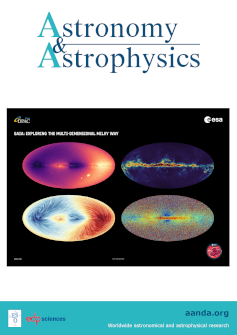CAPOS: The bulge Cluster APOgee Survey
IF 5.8
2区 物理与天体物理
Q1 ASTRONOMY & ASTROPHYSICS
引用次数: 0
Abstract
Context. The CAPOS project aims to obtain accurate mean abundances for many elements and their mean radial velocities, and it explores the multiple population (MP) phenomenon in Galactic bulge globular clusters (BGCs). NGC 6569 is one of the clusters observed by CAPOS.Aims. This study presents a detailed high-resolution spectroscopic analysis of NGC 6569 to derive high-precision mean abundances for a number of elements with various nucleosynthetic origins and to unveil its MPs by focusing on key spectral features. Our aim is to complement previous suggestions of the presence of MPs in this cluster based on the typical Na–O anticorrelation and the presence of a double horizontal branch.Methods. We analyzed the near-infrared APOGEE-2 spectra of 11 giant member stars in NGC 6569 using the code BACCHUS. We derived abundances for 12 elements, including light elements (C, N), α-elements (O, Mg, Si, Ca, Ti), iron-peak elements (Fe, Ni), the odd-Z element (Al), and s-process elements (Ce, Nd). We also performed an isochrone fitting using photometric data (Gaia + 2MASS) to estimate atmospheric parameters, the cluster distance, and its extinction.Results. We derived a mean metallicity of [Fe/H] = −0.91 ± 0.06, which is consistent with the values from the APOGEE pipeline and slightly more metal poor than previous findings. The scatter lies within the observational uncertainties. The cluster shows enhanced α-element abundances ([α/Fe] = 0.36 ± 0.06 dex) similar to other Galactic globular clusters (GCs). We find no significant variation in Al, suggesting a homogeneous distribution within the cluster. In contrast, we find considerable N-enrichment ([N/Fe] = 0.68 ± 0.34 dex) and a large spread of 0.90 dex, which enabled us to distinguish at least two separate populations based on N that have anticorrelated C abundances. The n-capture elements Ce and Nd are overabundant compared to the Sun, but are similar to those of GCs in this metallicity regime, and also show an average ratio of ⟨[Ce/Nd]⟩ = −0.17 ± 0.12. Finally, we estimated a mean radial velocity of RV = −49.75 ± 3.68 km s−1, which is consistent with previous measurements, but the heliocentric distance (d⊙ = 12.4 ± 1.45 kpc) and interstellar reddening (E(B–V) = 0.68) are higher than reported in the literature.Conclusions. The analysis confirms the presence of MPs in NGC 6569, evidenced by a significant spread in N and a clear C–N anticorrelation. This supports the previously established Na–O anticorrelation. MPs are characterized through this pattern for the first time. NGC 6569 exhibits chemical signatures typical of BGCs, without a significant spread in metallicity. The cluster α-element enhancement (consistent with early enrichment by type II supernovae) and the absence of a Mg–Al–Si anticorrelation agree with expectations for relatively high-metallicity GCs and suggests a rapid and homogeneous star formation history. The overabundance of n-capture elements indicates contributions from r-process events and might be linked to neutron star mergers. These n-capture elements are reported in NGC 6569 for the first time.CAPOS:凸起星团远地点调查
上下文。CAPOS项目旨在精确地获得许多元素的平均丰度及其平均径向速度,并探索银河系凸起球状星团(BGCs)中的多人口(MP)现象。NGC 6569是CAPOS.Aims观测到的星团之一。本研究对NGC 6569进行了详细的高分辨率光谱分析,以获得具有不同核合成起源的许多元素的高精度平均丰度,并通过关注关键光谱特征来揭示其MPs。我们的目的是补充先前基于典型的Na-O反相关和双水平分支存在的MPs在该簇中存在的建议。我们分析了NGC 6569中11颗巨大成员恒星的近红外APOGEE-2光谱,使用BACCHUS代码。我们得到了12种元素的丰度,包括轻元素(C, N), α元素(O, Mg, Si, Ca, Ti),铁峰元素(Fe, Ni),奇z元素(Al)和s过程元素(Ce, Nd)。我们还使用光度数据(Gaia + 2MASS)进行了等时拟合,以估计大气参数、星团距离及其消失。我们得到的平均金属丰度[Fe/H] = - 0.91±0.06,这与APOGEE管道的值一致,比以前的发现稍微少一些金属。散射存在于观测的不确定性之内。该星团α-元素丰度([α/Fe] = 0.36±0.06指数)与其他银河球状星团(GCs)相似。我们发现在人工智能中没有显著的变化,这表明集群内的分布是均匀的。相比之下,我们发现了相当大的N富集([N/Fe] = 0.68±0.34指数)和0.90指数的大分布,这使我们能够根据N区分出至少两个具有反相关C丰度的独立种群。与太阳相比,氮捕获元素Ce和Nd过于丰富,但在这种金属丰度制度中与gc相似,并且也显示⟨[Ce/Nd]⟩= - 0.17±0.12的平均比率。最后,我们估计了RV的平均径向速度= - 49.75±3.68 km s−1,这与之前的测量结果一致,但日心距离(d⊙= 12.4±1.45 kpc)和星际变红(E(B-V) = 0.68)高于文献报道。分析证实了MPs在ngc6569中的存在,证明了N的显著分布和明显的C-N反相关。这支持了先前建立的Na-O反相关。MPs首次通过这种模式来表征。ngc6569表现出典型的bgc化学特征,金属丰度没有明显的变化。星团α-元素的增强(与II型超新星的早期富集一致)和Mg-Al-Si反相关性的缺失与相对高金属丰度的gc相符,表明恒星形成历史快速而均匀。n捕获元素的过剩表明r过程事件的贡献,可能与中子星合并有关。这些n捕获元素是在NGC 6569中首次报道的。
本文章由计算机程序翻译,如有差异,请以英文原文为准。
求助全文
约1分钟内获得全文
求助全文
来源期刊

Astronomy & Astrophysics
地学天文-天文与天体物理
CiteScore
10.20
自引率
27.70%
发文量
2105
审稿时长
1-2 weeks
期刊介绍:
Astronomy & Astrophysics is an international Journal that publishes papers on all aspects of astronomy and astrophysics (theoretical, observational, and instrumental) independently of the techniques used to obtain the results.
 求助内容:
求助内容: 应助结果提醒方式:
应助结果提醒方式:


